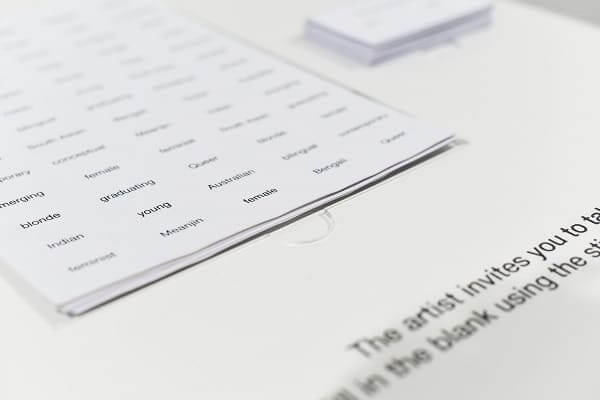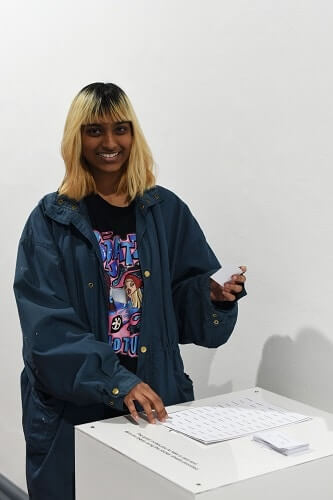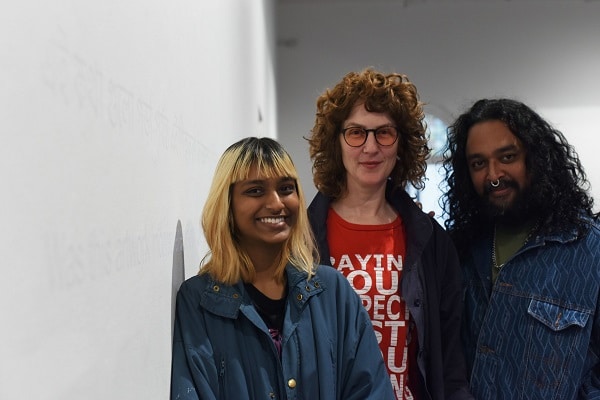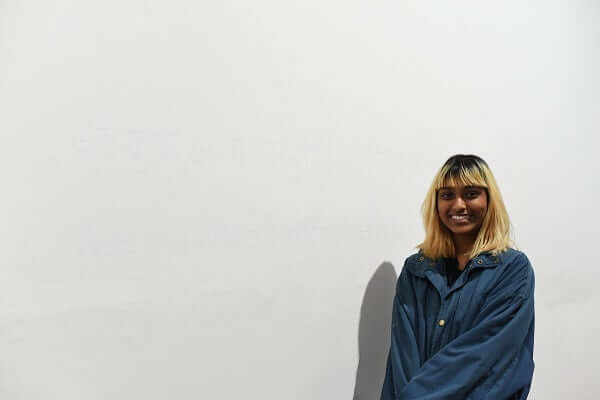Look at artist Paean Sarkar’s latest work, and you’ll think it is incomplete. In fact, you’ll think it is hardly there at all, until you look closely on the seemingly blank wall. Squint and you’ll begin to see some writing, in white, on white. Did the artist put in an unfinished work, you wonder.
And then you see the title, and it starts to make sense: এই শিল্পকর্মটি কি Incomplete? (Eyi shilpokormoti ki Incomplete?)
It won the 22-year-old Brisbane art student the Dr. Harold Schenberg Art Fellowship at the Hatched: National Graduate Show 2023 Schenberg Awards for Arts held in May.
‘এই শিল্পকর্মটি কি Incomplete?’ (Eyi shilpokormoti ki Incomplete?) reads the subtext in her native Bengali, translating to ‘Was the artwork complete until you read this text?’. The Bengali and English texts are scripted in white vinyl and stuck on the white of the museum walls.
The award-winning artwork is currently on display at the Perth Institute of Contemporary Art. Describing it, Sarkar explains that it is a lament on white male conceptual artists who have ruled the art world for long, yet restricting viewership to the masses.
It leaves you ruminating, a reaction that Paean Sarkar, a visual arts student at the Queensland University of Technology Brisbane, clearly intends to extract.

She enjoys audience involvement, as you can guess from her second work in the same exhibition. Titled simply Artwork by an Artist, it is again incomplete until you, the viewer, act to finish it. “This is an artwork by a _____ artist” reads the subtext, inviting visitors to pick from a variety of labels — cultural markers — to fill in the blank. The act is intended to get you thinking about identity. It is a gentle call to action that asks people to think about how they interact with art, and with other parts of their lives.
“I’ve been able to use the aesthetic language of conceptual art here to speak to you or offer you new avenues to explore,” Sarkar quips.
Conceptual art, she explains, is art in which the concept behind the work is more important than the finished object.
She reveals, laughing, that she often has to explain this to people. “When I tell people I’m an artist, they ask me to show something I’ve painted, or what medium I use!”
Growing up in a Bengali household, Sarkar’s life has been immersed in the arts and in creative endeavours.

“It’s in my blood!” she exclaims. “Mum is a singer and painter, and I grew up singing. Maybe that’s why I took a leap of faith and applied for the National Summer Art Scholarship back in 2016. I was among the 16 students from around Australia who got selected for a week-long, extensive programme at the National Gallery in Canberra.”
The short course was an eye-opener for Sarkar, who took instantly to the vibrant and immersive world of experimental art. “My approach to art changed after that, and I became much more rigorous. I became for instance, a great admirer of Serbian conceptual artist Marina Abramovich, and of performance art. And I learned to look art from a much more critical lens.”
Given her two most recent works, ‘এই শিল্পকর্মটি কি Incomplete?’ and ‘Artwork by an artist‘, it is clear that her art is a mirror to her soul as she comes to terms with her hyphenated identity.
“You could say my works are moving reflections of my life as the child of Indian immigrants in Australia,” she concurs.
Growing up in regional Queensland and being one of the few people of colour in her cohort in Warwick and then at university had its own impact on Sarkar.
“I felt this sort of pressure to talk about my background, but at the same time I would avoid getting boxed with the tag that I’m just another Indian artist; I am very much Australian.” She continues, “As a child, I was very much in denial of my Indian-ness. So at school, I saw myself as white. Then I conveniently switched identity and saw myself as a Bengali at the Bengali community gatherings that we would attend in Brisbane as a family,” she shares.
Sarkar used this perplexed emotional phase as a theme to create many of her works. “I’m still unpacking, or reconciling with, that mentality.”
Currently, she is working on marrying the two identities. “It is a very new thing for me.”

Lucky for her she has found a mentor in Sydney-based artist Ramesh Mario Nithiyendran, who brings to play his native and adopted identities quite admirably, and successfully, in his own work.
We wonder if being drawn to Nithiyendran’s maximalism, given her own minimalism, is a further statement to her quest for completion.
Like him, though, Paean Sarkar hopes with her art to get people to think about their own views, privileges, and the institutional structures that shape how they interact with art and life in general.
Read More: The unSensored brilliance of mOTHERTONGUE




